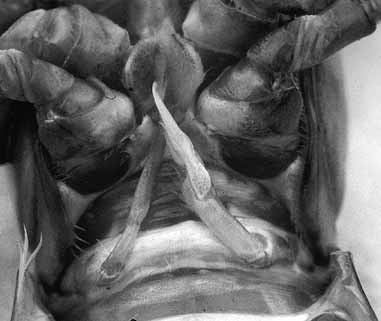
A bilateral gynandromorph: left, female with a soft first swimmeret; right, male with a hardened first swimmeret. Photo courtesy of Diane Cowan
Commercial Fisheries News - November 2000

A bilateral gynandromorph: left, female with a soft first swimmeret; right, male with a hardened first swimmeret. Photo courtesy of Diane Cowan
A lobster with a condition known as gynandromorphy occasionally appears in a lobster trap. Literally, gynandromorphy is a condition of having female and male reproductive characteristics.
The term comes from the Greek word roots “gyn” for woman, “andros” for man, and “morph” meaning shape or form.
Although gynandromorphs have male and female characteristics, they are generally unable to function as either male or female and the condition is often confused with another known as hermaphroditism.
Hermaphroditism is a natural biological condition for many animals that spend part of their lives as male and another part as female, or spend their entire lives as both sexes.
Gynandromorphy is not a natural part of lobster biology. It is extremely uncommon and represents a genetic abnormality that occurs in bilaterally symmetrical animals, including crustaceans and insects.
Published accounts of lobster gynandromorphy date back to 1730. Each record describes the anatomy of the gynandromorph. In all cases, male and female parts were found bilaterally both externally and internally — ovaries on one side and testes on the other.
Earlier this year, Friendship, ME lobsterman Gerry Lane donated a gynandromorphic lobster to The Lobster Conservancy. This lobster has female structures on the right and male parts on the left.
Studying live gynandromorphs has given me the opportunity to discover that, in addition to genetic abnormalities in structure, gynandromorphic lobsters show aberrant behavior, particularly in situations normally leading to mating.
A gynandromorph paired with a sexually receptive, freshly molted female lobster did not act like a male. Instead of copulating, the gynandromorph merely climbed over the female as though she was a rock. And when a gynandromorph molted, a male lobster ignored it and again no mating occurred.
Female lobsters extrude their egg masses whether or not they have mated. The unmated gynandromorph extruded half a batch of eggs that attached to one side of the abdomen. These unfertilized eggs eventually died, turned bright orange, and fell off.
However, other gynandromorphs may manage to mate. One donated to the Maine Department of Marine Resources was captured in the field with a half batch of eggs. Although the lobster dropped its eggs, scientists there were able to keep the eggs until two of them hatched. One of the offspring was male and the other was female.
It remains to be seen whether gynandromorphs are able to carry a brood to hatching in the wild.